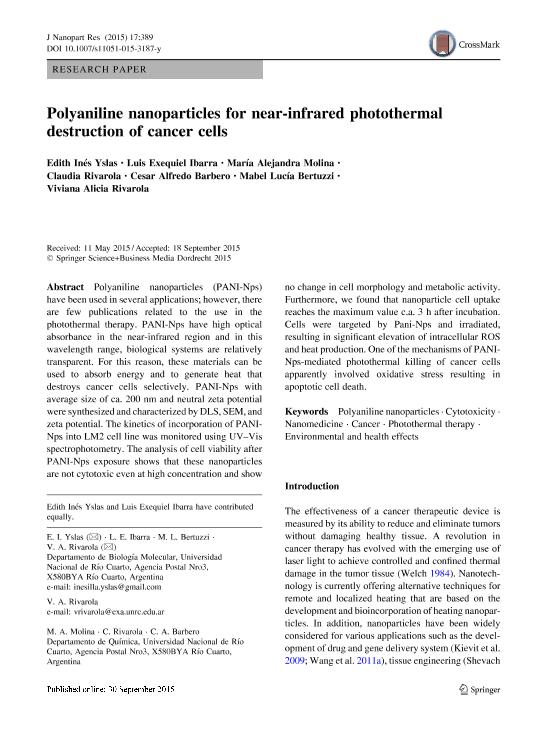Mostrar el registro sencillo del ítem
dc.contributor.author
Yslas, Edith Inés

dc.contributor.author
Ibarra, Luis Exequiel

dc.contributor.author
Molina, María Alejandra

dc.contributor.author
Rivarola, Claudia Rosana

dc.contributor.author
Barbero, César Alfredo

dc.contributor.author
Bertuzzi, Mabel Lucia

dc.contributor.author
Rivarola, Viviana

dc.date.available
2019-02-04T17:35:33Z
dc.date.issued
2015-10
dc.identifier.citation
Yslas, Edith Inés; Ibarra, Luis Exequiel; Molina, María Alejandra; Rivarola, Claudia Rosana; Barbero, César Alfredo; et al.; Polyaniline nanoparticles for near-infrared photothermal destruction of cancer cells; Springer; Journal of Nanoparticle Research; 17; 10; 10-2015; 1-15
dc.identifier.issn
1388-0764
dc.identifier.uri
http://hdl.handle.net/11336/69301
dc.description.abstract
Abstract: Polyaniline nanoparticles (PANI-Nps) have been used in several applications; however, there are few publications related to the use in the photothermal therapy. PANI-Nps have high optical absorbance in the near-infrared region and in this wavelength range, biological systems are relatively transparent. For this reason, these materials can be used to absorb energy and to generate heat that destroys cancer cells selectively. PANI-Nps with average size of ca. 200 nm and neutral zeta potential were synthesized and characterized by DLS, SEM, and zeta potential. The kinetics of incorporation of PANI-Nps into LM2 cell line was monitored using UV–Vis spectrophotometry. The analysis of cell viability after PANI-Nps exposure shows that these nanoparticles are not cytotoxic even at high concentration and show no change in cell morphology and metabolic activity. Furthermore, we found that nanoparticle cell uptake reaches the maximum value c.a. 3 h after incubation. Cells were targeted by Pani-Nps and irradiated, resulting in significant elevation of intracellular ROS and heat production. One of the mechanisms of PANI-Nps-mediated photothermal killing of cancer cells apparently involved oxidative stress resulting in apoptotic cell death. Graphical Abstract: [Figure not available: see fulltext.]
dc.format
application/pdf
dc.language.iso
eng
dc.publisher
Springer

dc.rights
info:eu-repo/semantics/openAccess
dc.rights.uri
https://creativecommons.org/licenses/by-nc-sa/2.5/ar/
dc.subject
Cancer
dc.subject
Cytotoxicity
dc.subject
Environmental And Health Effects
dc.subject
Nanomedicine
dc.subject
Photothermal Therapy
dc.subject
Polyaniline Nanoparticles
dc.subject.classification
Nano-materiales

dc.subject.classification
Nanotecnología

dc.subject.classification
INGENIERÍAS Y TECNOLOGÍAS

dc.title
Polyaniline nanoparticles for near-infrared photothermal destruction of cancer cells
dc.type
info:eu-repo/semantics/article
dc.type
info:ar-repo/semantics/artículo
dc.type
info:eu-repo/semantics/publishedVersion
dc.date.updated
2019-02-04T13:15:42Z
dc.journal.volume
17
dc.journal.number
10
dc.journal.pagination
1-15
dc.journal.pais
Alemania

dc.journal.ciudad
Berlin
dc.description.fil
Fil: Yslas, Edith Inés. Consejo Nacional de Investigaciones Científicas y Técnicas. Centro Científico Tecnológico Conicet - Córdoba; Argentina. Universidad Nacional de Río Cuarto. Facultad de Ciencias Exactas, Fisicoquímicas y Naturales. Departamento de Biología Molecular. Sección Química Biológica; Argentina
dc.description.fil
Fil: Ibarra, Luis Exequiel. Consejo Nacional de Investigaciones Científicas y Técnicas. Centro Científico Tecnológico Conicet - Córdoba; Argentina. Universidad Nacional de Río Cuarto. Facultad de Ciencias Exactas Fisicoquímicas y Naturales. Departamento de Biología Molecular; Argentina
dc.description.fil
Fil: Molina, María Alejandra. Consejo Nacional de Investigaciones Científicas y Técnicas. Centro Científico Tecnológico Conicet - Córdoba; Argentina. Universidad Nacional de Río Cuarto. Facultad de Ciencias Exactas Fisicoquímicas y Naturales. Departamento de Química; Argentina
dc.description.fil
Fil: Rivarola, Claudia Rosana. Consejo Nacional de Investigaciones Científicas y Técnicas. Centro Científico Tecnológico Conicet - Córdoba; Argentina. Universidad Nacional de Río Cuarto. Facultad de Ciencias Exactas Fisicoquímicas y Naturales. Departamento de Química; Argentina
dc.description.fil
Fil: Barbero, César Alfredo. Consejo Nacional de Investigaciones Científicas y Técnicas. Centro Científico Tecnológico Conicet - Córdoba; Argentina. Universidad Nacional de Río Cuarto. Facultad de Ciencias Exactas Fisicoquímicas y Naturales. Departamento de Química; Argentina
dc.description.fil
Fil: Bertuzzi, Mabel Lucia. Consejo Nacional de Investigaciones Científicas y Técnicas. Centro Científico Tecnológico Conicet - Córdoba; Argentina. Universidad Nacional de Río Cuarto. Facultad de Ciencias Exactas Fisicoquímicas y Naturales. Departamento de Biología Molecular; Argentina
dc.description.fil
Fil: Rivarola, Viviana. Consejo Nacional de Investigaciones Científicas y Técnicas. Centro Científico Tecnológico Conicet - Córdoba; Argentina. Universidad Nacional de Río Cuarto. Facultad de Ciencias Exactas Fisicoquímicas y Naturales. Departamento de Biología Molecular; Argentina
dc.journal.title
Journal of Nanoparticle Research

dc.relation.alternativeid
info:eu-repo/semantics/altIdentifier/url/https://link.springer.com/article/10.1007/s11051-015-3187-y
dc.relation.alternativeid
info:eu-repo/semantics/altIdentifier/doi/https://doi.org/10.1007/s11051-015-3187-y
Archivos asociados
